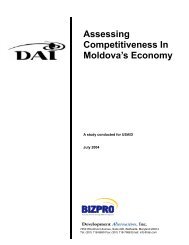the ties that bind - Economic Growth - usaid
the ties that bind - Economic Growth - usaid
the ties that bind - Economic Growth - usaid
You also want an ePaper? Increase the reach of your titles
YUMPU automatically turns print PDFs into web optimized ePapers that Google loves.
<strong>the</strong> buyer/supplier relationship do not always present <strong>the</strong> best long- term strategy for<br />
success to those suppliers. In fact, <strong>the</strong>se relationships typically put <strong>the</strong> supplier at risk of<br />
relying too heavily on one buyer for <strong>the</strong>ir company‟s overall success, and if for any<br />
reason <strong>the</strong> buyer discontinues <strong>the</strong> relationship, <strong>the</strong> supplier suffers. Facilitators can help<br />
mitigate <strong>that</strong> risk by helping suppliers understand <strong>the</strong> incentives and market drivers of<br />
<strong>the</strong>ir buyers. They can also support suppliers by helping <strong>the</strong>m create market-positioning<br />
strategies <strong>that</strong> anticipate future market opportuni<strong>ties</strong>. Not all suppliers will benefit from<br />
winning large contracts with retailers.<br />
O<strong>the</strong>r facilitators focus on very high-value products <strong>that</strong> end up sourced only in very<br />
high-end markets. While <strong>the</strong>se transactions command higher prices and profits to <strong>the</strong><br />
supplier, <strong>the</strong> model does not scale well enough for broader impact in developing<br />
countries as <strong>the</strong>re are not enough highly skilled artisans to participate in <strong>the</strong><br />
supplier/buyer relationships on a larger scale. Facilitators play a critical role in helping<br />
suppliers understand <strong>the</strong> risk/reward associated with <strong>the</strong>se differing strategies.<br />
Whe<strong>the</strong>r <strong>the</strong>y are working with suppliers of large scale retailers or boutiques, donor<br />
officers have a role to play in ensuring <strong>that</strong> <strong>the</strong> relationship adhesives in figure 1 are in<br />
place and functioning well. However, not all facilitation is good. If designed in <strong>the</strong> wrong<br />
way, a donor-driven market linkage can result in donor dependence or worse, a<br />
distortion in <strong>the</strong> market and an inefficient misallocation of scarce investment resources.<br />
The six cases highlight a number of design principles for donors <strong>that</strong> are considering a<br />
market linkage intervention:<br />
Understand and align incentives among buyer, supplier and facilitator. Buyers<br />
often do not understand <strong>the</strong> production capaci<strong>ties</strong> and business environment of a<br />
particular country and so structure orders and contracts <strong>that</strong> are not aligned with<br />
local conditions. Similarly, suppliers rarely understand <strong>the</strong> end-market needs<br />
and trends for <strong>the</strong>ir products and so are not fully aware of <strong>the</strong> buyer‟s business<br />
model. The donor, as a facilitator, is uniquely positioned to bridge this gap, if it<br />
exists.<br />
Foster a buyer-supplier relationship in which <strong>the</strong> buyer is transferring end-market<br />
information directly to <strong>the</strong> supplier on a regular basis. Buyers often fail to<br />
communicate end market needs back to <strong>the</strong>ir suppliers, and deal with <strong>the</strong>ir<br />
suppliers on a “need to know” basis. Again, <strong>the</strong> donor is well-positioned to foster<br />
a more open relationship.<br />
Support open, transparent and regular planning / reporting between buyer and<br />
supplier. Suppliers can be too ambitious in <strong>the</strong>ir production promises. Regular<br />
reporting is critical to building and preserving trust with international buyers.<br />
Build <strong>the</strong> capacity of <strong>the</strong> supplier in customer relationship management (CRM)<br />
skills. Current market linkage projects invest in production upgrading and<br />
creating <strong>the</strong> initial linkage, but stop short of providing extended support in<br />
learning how to manage <strong>the</strong> relationship. CRM tools and techniques can be<br />
instrumental in ensuring a supplier is able to stay connected to its buyer over<br />
time.<br />
Establish clear and transparent criteria and support third party quality control and<br />
certification agents in sectors which require high quality and social responsibility<br />
standards.<br />
Support suppliers in understanding <strong>the</strong> risk/reward associated with different<br />
market penetration strategies<br />
www.Business<strong>Growth</strong>Initiative.org<br />
11

















